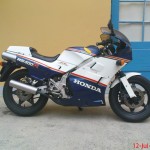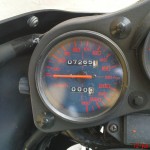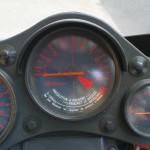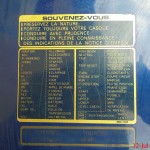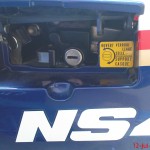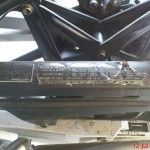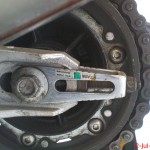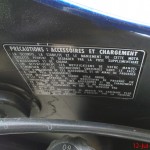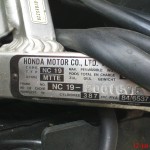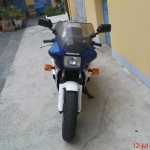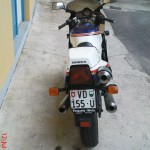More parts cross-ref…
If you don’t a position ring (the half moon that keeps crank bearing into place)… it’s OK, they get lost a lot, but they need to be there.
Just use a H1 ring, they’re the same.
Part # = 14013-1004
Part Description = POSITION RING
Model Count = 179
A1 N/A 250 SAMURAI DUAL PURPOSE
A1R N/A 250 A1R STREET
A1SS N/A 250 SAMURAI SS DUAL PURPOSE
A7 N/A 350 AVENGER DUAL PURPOSE
A7SS N/A 350 AVENGER SS DUAL PURPOSE
H1 N/A 500 H1 MACH III STREET
H1B 72 500 H1 MACH III STREET
H1C 72 500 H1 MACH III STREET
H1D 73 500 H1 MACH III STREET
H1E 74 500 H1 MACH III STREET
H1F 75 500 H1 MACH III STREET
KH500-A8 76 500 KH500 STREET
If you’re missing a hub, this list will help you find a replacement:
Part # = 41034-007
Part Description = FRONT BRAKE DRUM ASSEMBLY
Model Count = 13
A1 N/A 250 SAMURAI DUAL PURPOSE
A1SS N/A 250 SAMURAI SS DUAL PURPOSE
KH250-A5 76 250 KH250 STREET
S1B 74 250 S1B STREET
S1C 75 250 S1 STREET
A7 N/A 350 AVENGER DUAL PURPOSE
A7SS N/A 350 AVENGER SS DUAL PURPOSE
S2 72 350 S2 STREET
KZ400 74 400 KZ400 STREET
KZ400D 75 400 KZ400D STREET
KZ400S 75 400 KZ400S STREET
KZ400-S2 76 400 KZ400 SPECIAL STREET
KZ400-S3 77 400 KZ400 SPECIAL STREET
Thanks to III from the KTW Board
Info kindly supplied by Gerrit on the KTW board… This is priceless!
“NTN still list their EC bearings as available- these have two orange plastic rings in their outer races which took up any difference in expansion between bearing outer race and crankcase. Kawasaki used them for their road racers such as H1-R, H2-R and KR750. H1-R cranks used all-roller main bearings, and later apparently switched to cranks with small main roller bearings and large main ball bearings; I have seen one such crank brand-new in the original box.
For the H1, you would require three EC6205/C3, two EC6305/C3 and one EC6305N/C3.
For the H2, three EC6206/C3, two EC6306/C3 and one EC6306N/C3.
For S series, three or five (depending on whether you have a four-bearing or six-bearing crank) EC6305/C3 and one EC6305N/C3.
For the A1/A7, three EC6305/C3 and one EC6305N/C3.
ONLY NTN make these bearings, so be sure to specify NTN when ordering from your friendly bearing supplier.
EC, by the way, stands for “Expansion Compensation”.
The roller bearings for the H1-R are the NTN ECNJ205G1/C3 and ECNJ305G1/C3, and these may also be available, but these are FILTHY expensive………”
This solves my problem of finding good enough bearings for the A1R… now where to get them?
I’ll go into the nitty gritty later… here’s the short list of modifications made to the A series. It can help you to ID your basket case…
check also the “Model reference” category on the right. It’ll show you actual examples. Why not send me pics of your bike?
Just drop me a comment here (check the form at the bottom of the page) with your email.
1967-1968 models
These motors have the 2-part disc valve, with a pin retaining the disc. Disc are made in phenolic resin with a steel center.
Samurais have a 2-tone tank with knee grips and white hand made stripe, they came in candy red or blue. Combination unit for tach/speedo.
Side panels are in aluminium grey with a thin “Autolube” sticker.
Avengers have a chrome panelled tank with knee grips and came in blue. Combination unit for tach/speedo. Side panels are in the color of the bike.
All have a deep, almost valanced, chrome rear fender.
These bikes are sought after because they look… well… vintage! But by the end of 1967, this design was already a bit outdated.
1968 models
Speedo and Tach are separated and round.
new headlight shape, similar if not identical to the early H1.
Tanks keep the previous design but don’t have chrome panels or knee-grips. The paint scheme is the same, with a hand made stripe.
Side panels are in the color of the bike, with a large trapezoidal sticker.
Similar to a 1967 Samurai tank sans knee grips. Red or blue, see my Scrambler to see the color. The colors are different from the previous year and have a LOT of metal flakes in them.
New Stainless steel rear fender, thinner design, will last until the end of production.
Note: these are the models that also were sold in 1969. Think of them as parts bin specials.
Low production run: ~ 1’500 made.
1969 models
New disc using a gear-like sleeve to link them to the crankshaft. Much better design. The discs are entirely in resin.
the front fork has a new internal design, with new fork ear design, less triangular and with a reinforcement on the inside.
Speedo and Tach are separated and round.
New style (fatter)brake and clutch hand levers.
New style of rear light with round reflector part on top.
New style of hand controls (the markings on the LH are different).
Tanks keep the previous design but has a new oval paint scheme, red or yellow. The red is a very nice shade of candy burgundy. Tank paint scheme was obviously changed mid-year, as there are two different brochures.
New design for the gear changing drum.
New design for the rear swinger, specifically the bush.
350 Avenger gets new 28mm carbs, upping the power to 42 HP and new pipes (with a C engraved, previously there was an A. Don’t know where the B got lost)
1970 models
New tank with a rectangular form. Paintjob is an adaptation of the previous year. The red color is again different, not burgundy, but a “straighter” red. Tank has a recess on top (what for?).
The 250 gets a new head gasket in copper only (previously instead of a asbestos-copper mix).
The 350 has new rings with an expander ring under the 2nd ring. Colors are red or yellow, again different from previous year’s shades.
1971 models
New tank, same shape but no recess on top. New paintjob, white for all models with gradient-like stickers on side of tank and sidecovers.
Accents are blue for the 350 and orange for the Samurai. Last model year before the S1 and S2… End of the line.
If you’d love to agree or disagree with the above, just drop me a line here in the comment section.
This is a question I’ve been asked so frequently in the past, I thought it would make a good introduction to my new Model Info & study section. This will hopefully cover all the bikes featured on the site.
Kawasakis of the period didn’t have matching frame/engine numbers. Engine number is usually between from 50 to 200-300 range from the frame #, although later the diffrence ranged up to ~1’500.
The motor numbers are always higher than the frame numbers, same thing applies to the Triples for example. This is due to the way they made them at the factory, when ramping up production: motors might be more complex to assemble, but actual assembly is faster.
So when assembly started, the gap between the numbers was low and went up as the year went on. Numbering didn’t stop between the change from model year to model year. The last ’71 models had a large number difference between motors and frames. The early 67 models had a very small difference in numbers, maybe due to more precise assemblies and the fact that it didn’t sell, the company wouldn’t be submerged in leftover motors.
Since there were modifications to the motors specs (more on that later), it could well be possible that Kawasaki reset the numbering at the the start-of-model-year numbering. In this case the next model year frame #, were in fact just a few up on the last motor # produced the year before, to start a new model with a “round” number. The leftover motors were probably used for under warranty exchanges.
So the difference should always be greater at the end of the year than at the start. And there SHOULD be a very very few matching numbers bike, with very early model year numbers.
Hope it makes sense…
So here’s the list: it pertains to the frame numbers only. These are from Kawasaki themselves and can be trusted.
| A1 Samurai |
A7 Avenger |
1967: frame #0 to 9373
1968: frames from # 9374
1969: frames from # 10810
1970: frames from # 14850
1971: frames from # 17855 up to ? |
1967: frame #0 to 11599
1968: frames from # 11600
1969: frames from # 13840
1970: frames from # 20540
1971: frames from # 25468 up to ? |
|
The high numbers for 1967 are explained by the initial prodution, remember it was Kawasaki’s last-ditch effort to gain a foothold in the world market. A lot of 1967 models were also sold in 1968, it all depended on which market. The US market was the first targeted, then Europe. So you can think of the early 67-68 production as stock for a world takeover…
We can be glad that the A series received rave reviews and sold well: if it hadn’t been the case, the Kawasaki Group of companies (not yet KHI, Kawasaki Heavy Industries) would have shut down the motorcycle division and written that side of their business off. To this day, the motorcycle division only accounts for a small part of KHI’s profits.
If you have a late, early or matching frame #, do drop me a line, I’d like to estimate the end of the production. Just use the comment form under this post.
Just a quick note to myself:
Due to the GFC, funds are very low… it looks like the Samurai will have to be enjoyed as is, as I can’t really afford to sink more money into it.
What’s good: Bike runs, shifts and brakes. All electrickery works APART from…
Horn and blinkers. So what’s bad:
Horn, blinkers, seat and eventually putting a old-style oil tank.
Tried all sorts of things with the horn. There is a high suspicion of a duff brown wire. It looks chaffed and as if it had been repaired some time in the past. Running a direct positive wire frome the bat and actioning the button gives a loud HONK… but this didn’t last. Voltage at the brown wires is only 4.6V, so the wires should be the cuplprit BUT now I can’t get the horn to work at all. Will check at Franky’s with known good batteries. I might have fried the (rare) original horn. To top it off the horn button is now falling to pieces.
Easy solution would be buying the correct (for the year) switches, for both sides, but that’s a no-no. And a new horn.
If I want to add blinkers I need to source a extra rear one or modify one of my fronts. They’re so rare, I’d rather not think about it.
The Samurai being fairly well-mannered and silent bikes, a horn is a safety measure, IMHO. Blinkers are as handy as rear view mirrors…
The seat cover needs to be sorted at Pit-replicas, very good quality. then the foam needs to be sorted. More dollars…
I think I’ll button it up again and just live with it for a while.
The bike now running, I had to reset the clutch and true the rear wheel and get the chain a touch tighter. A test ride should be in the plans soon. Over the years, I’ve found a few original saddles, They look much better than the one we made using photographs. You’ll also notice the correct (and rare as hell) blinkers… of course, I’ve got 3 fronts and one rear…
And have to find how to connect the flasher units. The signals were an option, so I suspect the relay was planted wherever the local spanner monkey thought it fit.
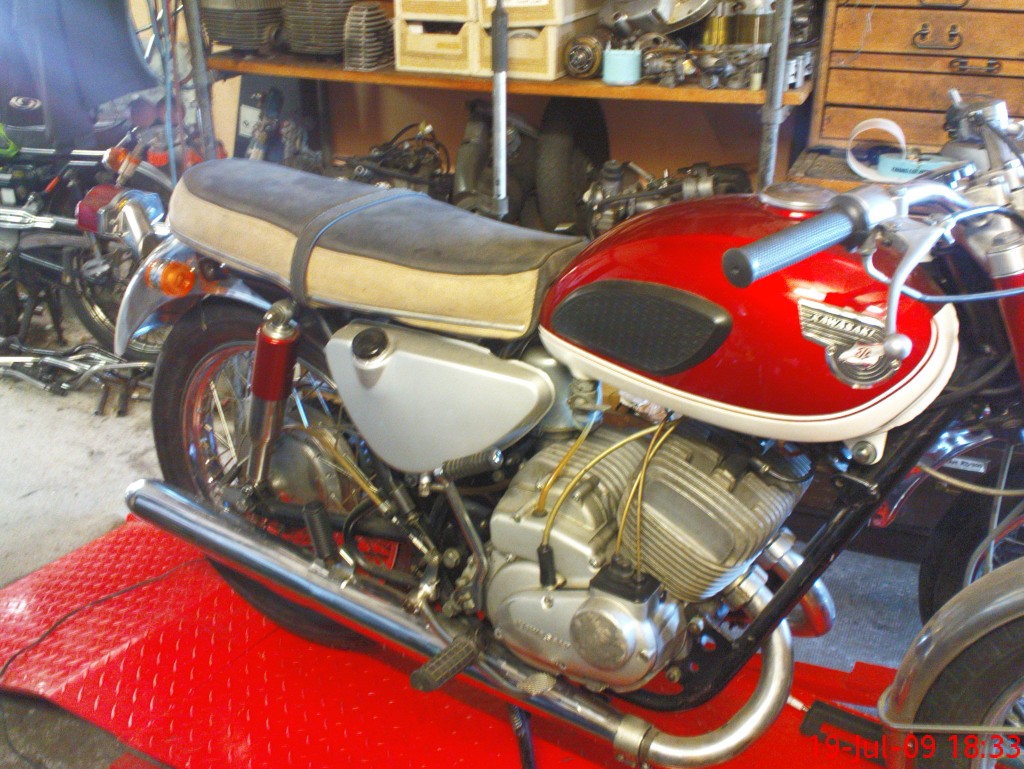
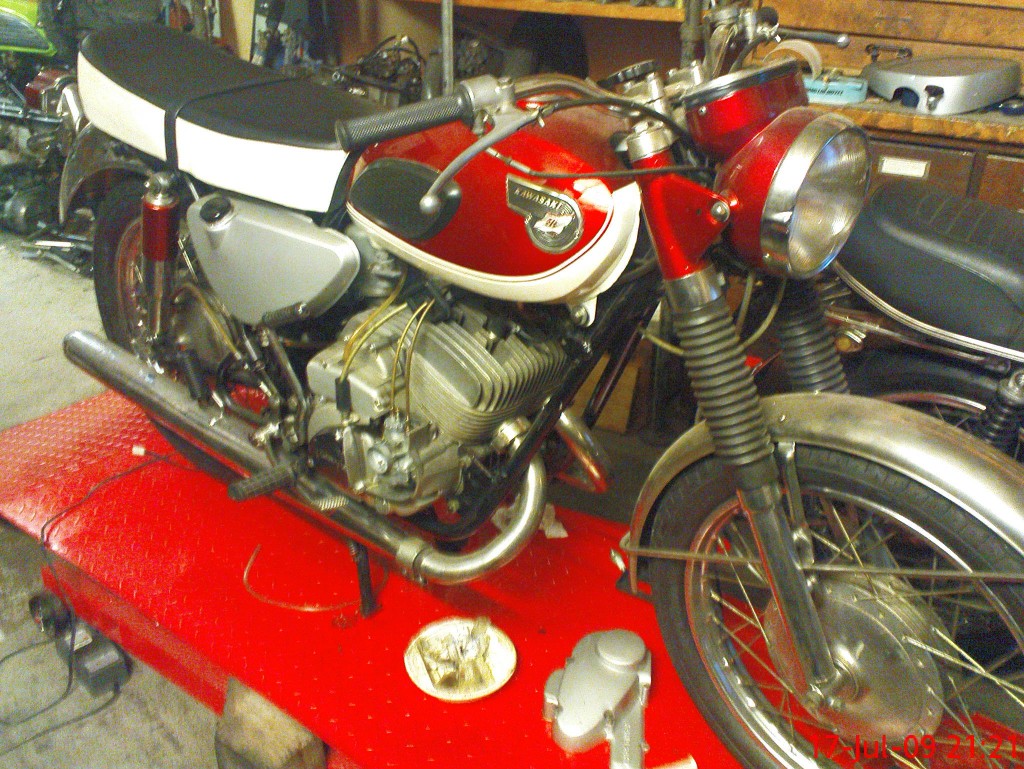
In order to adjust your carbs without splashing oil everywhere, you want this bit:
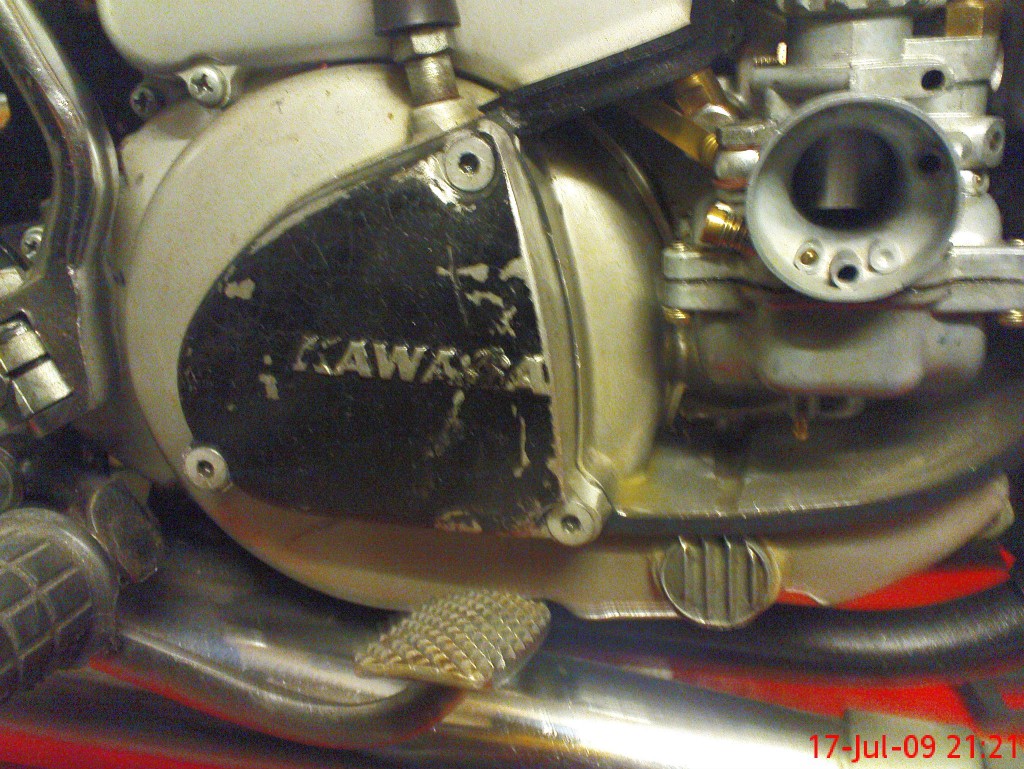 Just use a cracked cover and chop it. It’s also a good idea to keep the oil level slightly lower than mentioned in the manual, you need about 20cc less. That way the oil will just be level with clutch casing’s opening.
Just use a cracked cover and chop it. It’s also a good idea to keep the oil level slightly lower than mentioned in the manual, you need about 20cc less. That way the oil will just be level with clutch casing’s opening.
You can also see a bit of oil below the carb: this is injector oil. This means your banjo is leaking! That’s an imperative fix.
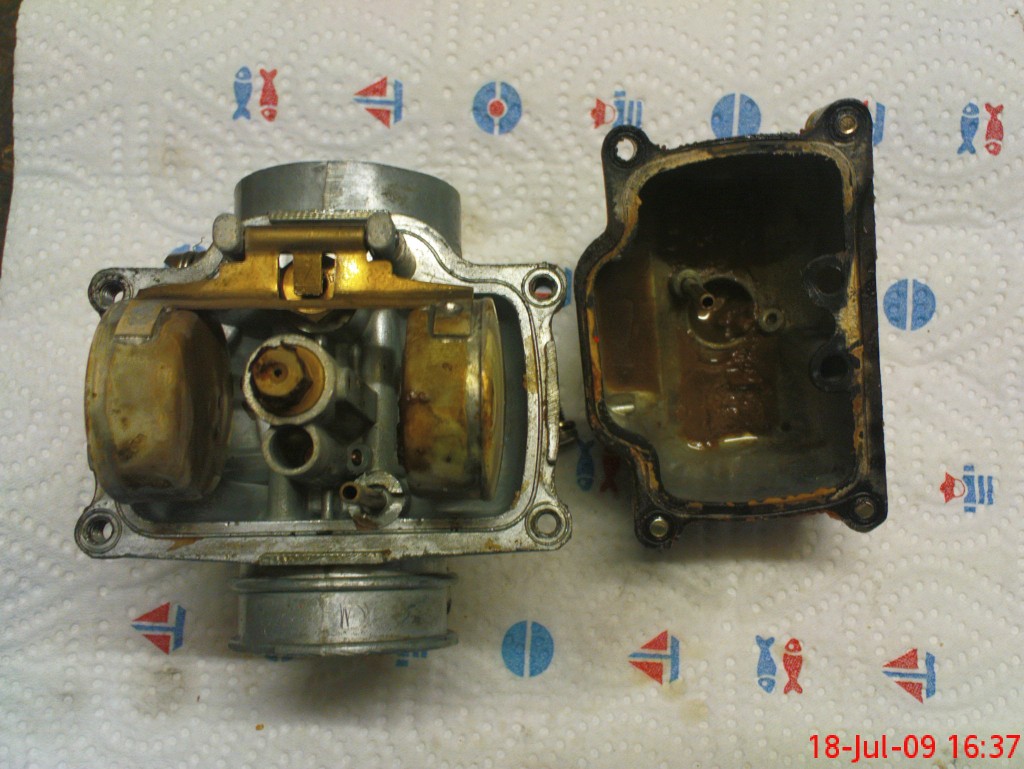 2 years is just enough time to have the carbs gum up, the gunk in the bowl felt like grease.
2 years is just enough time to have the carbs gum up, the gunk in the bowl felt like grease.
After a touch of ultrasound cleaning, the bike runs now perfectly. The fuel stabilizer does really work, normally after 2 years the unleaded fuels just goes bad. I use Motorex fuel stab, which is meant for snowmobiles.
Well, I’m almost over with the DS6 so decided to tackle the Samourai again. The last time I tried to start it some 2 years ago, it nearly killed me.






